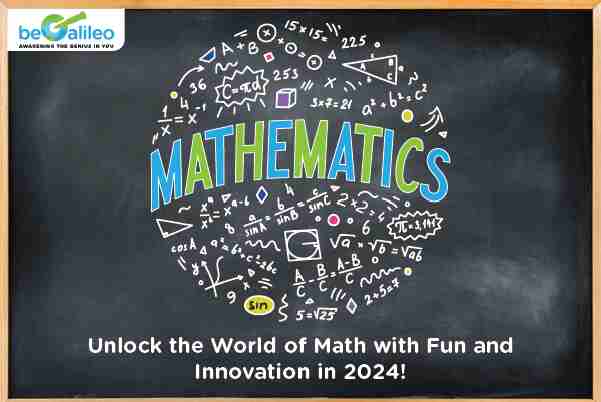
Unlock the World of Math with Fun and Innovation in 2024!
Embark on an exciting journey as we unlock the world of math with fun and innovation in 2024! At BeGalileo, we're passionate about revolutionizing math education, and this year promises to be our most innovative yet. Join us as we revolutionize math education for children by fusing cutting-edge technology, constructivist teaching strategies, and engaging teaching methods.
Despite the fact that mathematics has historically been seen as a difficult and even intimidating subject, the field of math education has seen radical change with the advent of educational technology.
One of the main factors changing the way math is taught and learnt is the advent of modern technologies. Learning experiences that are engaging and immersive while accommodating a variety of learning preferences may now be produced thanks to interactive software and simulations, educational applications, and internet resources. In addition to making math more understandable, these materials allow students to investigate mathematical concepts in previously unimaginable ways. Online math tutors are transforming math education into a dynamic field sparking students' interest, ingenuity, and love for learning by apt utilization of educational technology.
Our goal at BeGalileo is to provide students of all ages with an engaging, relevant, and fun math education. Students will be able to investigate mathematical ideas in a dynamic and engaging setting by using our interactive platform. In 2024, we promise to take our Math help online to the next level. New features are constantly being added to our platform to further customize and engage students in their learning path.
Unlock Your Child's Math Potential with beGalileo!

🚀 Transform their math skills with personalized, 1-on-1 classes.
🧮 Experience integrated math and coding for real-world application.
👦 See your child excel—start with a Free Trial Math Class today!
We're always pushing the envelope of what's possible in math education, from gamified challenges that turn math into an exciting adventure to adaptive learning algorithms that customize content to individual learning styles.
As we strive to explore new ways to improve math education, we at beGalileo incorporate the leading five solutions that use new technology to help educators solve pervasive challenges with ease.
One-on-one learning:

In an online virtual math learning platform, one-on-one learning involves personalized instruction tailored to individual students' needs and learning styles. Our online math teachers focus on solving particular learning difficulties, facilitate pupil learn at their own pace, and encourage a better comprehension of mathematical ideas. One-on-one instruction can significantly enhance student's comprehensive power of maths, according to research.
In the "Journal of Educational Psychology," it's found that students who received one-on-one instruction had a statistically significant boost in their mathematics knowledge. According to the study, pupils who got individualized one-on-one education outperformed those in regular classroom settings by 30% in arithmetic skills. This notable advancement demonstrates how well-tailored instruction may meet the unique learning requirements of each student and advance their mathematical competency.
Our online tutor's involvement is critical to the effective implementation of this individualized learning methods. Our teachers conduct one-on-one online classes twice a week, using our innovative content based on the constructivist teaching method developed by our highly specialized content team. The constructivist method of teaching advocates for a learning process that builds upon students' existing knowledge and experiences. Instead of bombarding learners with abstract concepts from the outset, this method encourages educators to start with what students already know and gradually introduce new ideas in a way that is meaningful and relevant to them. By making links between their known and unknown knowledge domains, students get a deeper understanding of mathematical concepts and their practical applications.
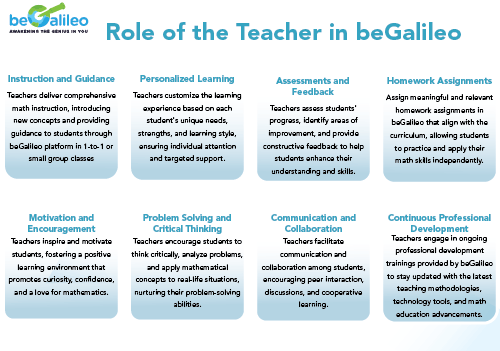
One tip for implementing one-on-one learning in an online virtual math platform is to use diagnostic assessments to identify each student's strengths, weaknesses, and learning preferences. At BeGalileo, we offer the diagnostic MIDAS test, which allows teachers to assess a child's specific strengths and weaknesses even before they begin classes on the BeGalileo platform. By understanding each student's unique learning profile, our teachers tailor their instruction to suit individual needs, providing targeted support where it is most needed.
Additionally, our teachers incorporate interactive and collaborative activities into one-on-one virtual sessions that can enhance engagement and facilitate a deeper understanding of math concepts. Virtual tools such as interactive whiteboards, multimedia resources and simulations are used amply to create dynamic and interactive learning experiences that cater to diverse learning styles.
Enhancing Math Learning Through Coding

Incorporating coding into math education on an online virtual platform can significantly enhance the learning experience by providing a practical application of mathematical concepts and fostering critical thinking skills. Students who learn to code acquire computational abilities as well as a stronger comprehension of mathematical ideas and their practical applications.
By showing students how mathematical ideas can be used to solve problems and develop solutions, coding makes math more approachable and interesting. Students may investigate mathematical ideas in a hands-on way through coding projects, strengthening their comprehension through real-world application. These concepts include algorithms, logic, and patterns.
At BeGalileo, we have observed that coding makes math real and exciting for students. In fact, 40% of our students have reported improvements in their problem-solving skills through coding. This statistic highlights the effectiveness of coding as a tool for enhancing mathematical understanding and critical thinking in an online virtual learning environment.
We incorporate coding into every hour-long math class during the last 15 minutes. This integration aims to show students that logical learning is a natural part of math programs. Each 15-minute coding lesson is designed to complement and reinforce the math concepts learned. For example, in a game called "Space Division," students follow on-screen instructions to fight aliens, all while learning the divisibility rule of numbers. It's both fun and educational—a perfect combination for students!
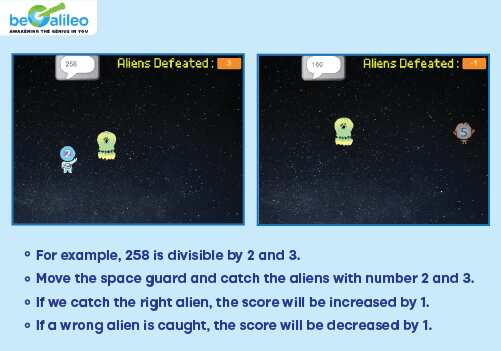
Additionally, teaching students to code fosters logical and analytical thinking—skills necessary for success in mathematics. Students that participate in coding exercises learn to deconstruct complicated issues into smaller, more manageable steps—a method that is similar to mathematical problem-solving techniques.
An online virtual platform that incorporates coding into math instruction can result in better problem-solving abilities, a more thorough comprehension of mathematical ideas, and an all-around more enjoyable learning environment. Teachers may enable children to become adept in computational thinking and mathematics by using coding as a teaching tool.
Gamified Learning in Mathematics: A Winning Formula for Engagement and Retention

Gamified learning, the integration of game elements into educational contexts, has emerged as a promising strategy for enhancing mathematics education. The key advantage of gamified learning in mathematics is its ability to increase student engagement.
This whole vision is incorporated by encouraging students to take an active role in their education by teaching mathematical topics through interactive games, puzzles, and challenges. Games' rewarding and competitive elements allow players a sense of accomplishment and advancement and encourage a good attitude toward mathematics.
Gamified learning has also been shown to improve recall of mathematical concepts and skills. Games provide students the chance to practically apply their mathematical knowledge, which can enhance their understanding and retention of the material since they are interactive.Compared to traditional teaching approaches, students who participate in gamified learning activities exhibit greater levels of information retention
At BeGalileo, we think that gamified learning can be used to make math more interesting and useful for students. Our platform provides a range of games, such as Math Zone and Speed Math, that are intended to improve mathematical abilities. These games are designed with care to complement learning goals and offer a fun, engaging learning environment.
In Math Zone, both educators and students can maximize the potential of BeGalileo's online adaptive learning platform. This platform's key feature is its ability to adjust to each student's individual learning pace. The difficulty level of the questions presented to a student is determined by their responses to previous questions. Correct answers lead to an increase in difficulty, challenging the student to progress further. On the other hand, incorrect answers prompt the platform to lower the difficulty level, ensuring that the material is comprehensible.
To motivate and reward students for their progress, the platform offers incentives such as stars, smiley faces, clapping hands, and thumbs up icons when they consistently perform well. These rewards not only boost students' confidence but also contribute to the enjoyable nature of the module, enhancing the overall learning experience.
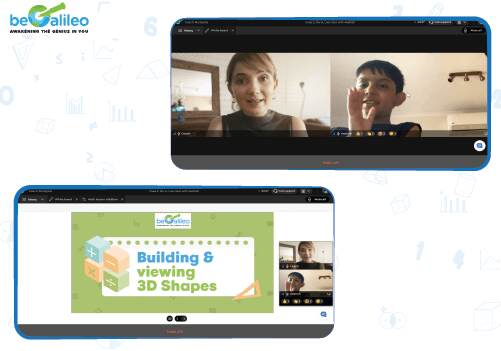
Speed Math is a game that challenges students to solve math problems quickly and accurately, improving their mental math skills and response times. By engaging in timed math challenges, students can sharpen their calculation abilities and develop a more intuitive understanding of numbers and operations.
Apart from Math Zone and Speed Math, BeGalileo provides various other gaming activities, such as check-in and check-out activities, designed to accommodate different learning styles. These activities foster creativity and even help develop a child's emotional intelligence.
Studies have consistently shown that gamified learning in mathematics is bears success. Research indicates that gamified learning may improve math engagement and retention by more than half, indicating that it can greatly improve the learning process. Through the utilisation of gamified learning, platforms such as BeGalileo are revolutionising mathematics education by augmenting its interactive, captivating, and efficacious nature for learners throughout the globe.
Visual Learning and Simulation:
At BeGalileo, we acknowledge the importance of visual learning and simulation approaches in helping students grasp mathematical ideas and in making math more approachable and interesting. We aim to present students with engaging experiences that foster better knowledge and learning in a range of mathematical areas, including geometry, algebra, and number theory, by blending simple simulations with complex mathematical concepts.
Geometric concepts such as shapes, angles, and transformations may be visually represented using basic simulations. Students may investigate the characteristics of geometric figures, work with forms to comprehend transformations, and see geometric relationships in a concrete way by interacting with dynamic representations. In addition to making difficult subjects easier for students to understand, this hands-on method to teaching geometry helps students build an intuitive knowledge of geometric concepts and understanding of shapes.
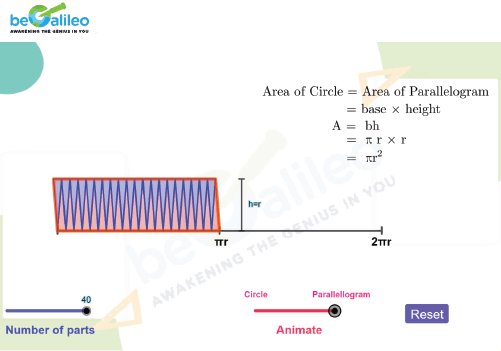
Simulations are very useful for helping students visualize algebraic expressions, equations, and functions. Students may solve equations, graph functions, and investigate algebraic features using basic simulations, which helps them to build a visual understanding for algebraic ideas and processes. Students can develop a greater knowledge of algebraic principles and their practical applications by seeing how changes in variables impact the behavior of functions or the solutions to equations.
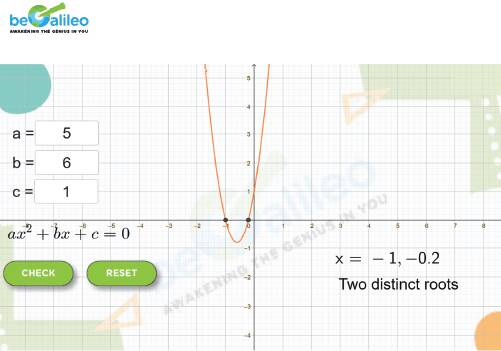
In the realm of number theory, simple simulations can be used to illustrate concepts such as divisibility, prime numbers, and operations on the number line. By visualizing number patterns and relationships, students can explore the properties of numbers in an interactive way, gaining insights into fundamental number theory concepts. Simulations can also help students understand complex number operations and properties by providing visual representations that make abstract concepts more concrete and comprehensible.
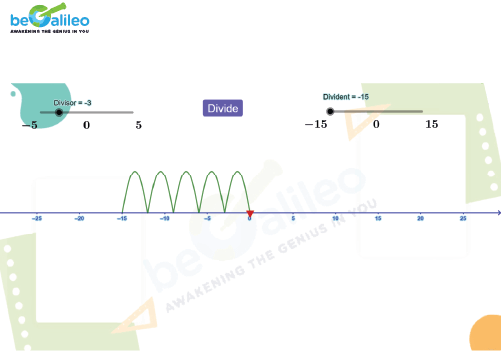
Even our coding lessons can help students visualize abstract mathematical concepts through interactive simulations and visualizations. Math may be more understandable and effective when taught visually, especially for children who have trouble grasping abstract ideas.
The Power of Multiple Solutions

Examining many approaches while solving math problems is an effective strategy that stimulates students' critical and creative thinking. In BeGalileo, we emphasize the importance of this method by providing opportunities for students to engage in brainstorming sessions with the teachers to solve various math solutions on a whiteboard or a digital screen. By helping the students to explore different methods of problem-solving, we aim to sharpen their mathematical acumen, critical thinking and visualization power.
Students are constantly encouraged to think outside the box and consider multiple approaches to solving a problem. This process not only cultivates a deeper understanding of mathematical concepts but also promotes a flexible and adaptive mindset that is essential for tackling complex problems. Students are able to visually compare and contrast alternative tactics and get insight into the advantages and disadvantages of each strategy by showing many solutions for the same problem.
The Socratic style of teaching, in which the teacher acts more as a facilitator by leading students through a sequence of questions that urge them to think carefully about a topic, is the foundation of the whole educational approach in examining numerous answers. Rather than providing direct answers, the teacher prompts students to analyze, question, and evaluate their own ideas. This process challenges students to articulate their thoughts clearly, defend their positions, and consider alternative viewpoints.
The shift from a focus on "how" to a deeper understanding of "why" is what beGalileo emphasizes on. Instead of simply memorizing procedures students are encouraged to explore the underlying principles and logic behind every mathematical concept. This gives mathematics a deeper meaning while also enabling pupils to use what they've learned in a range of situations and scenarios.
Consider the lesson on Quadratic Equations as an example. Rather than simply defining a quadratic equation, the goal is to gradually introduce the concept, starting with a basic linear equation in one variable. The teacher guides students to understand that the solutions of an equation represent the values that satisfy it, which are also known as the zeros of the function when expressed in that form. These solutions are also referred to as the roots of the function. When the equation or function is graphed, these solutions correspond to the points where the graph intersects the x-axis. Throughout the lesson, our educators guide students to realize the interconnectedness of these concepts, encouraging them to arrive at the answers through a Socratic approach, rather than simply providing the solutions outright.
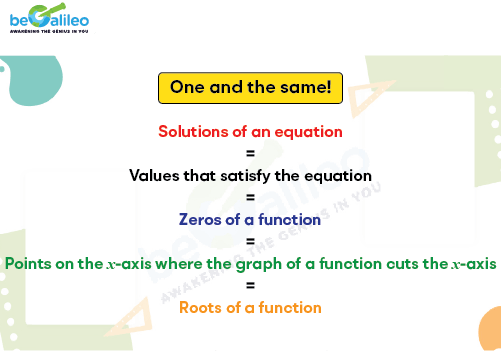
The act of exploring multiple solutions is not only beneficial for solving individual problems but also for developing a broader mathematical mindset. It pushes pupils to be inventive and open-minded, looking for many approaches and viewpoints to solve problems. This mindset is invaluable in mathematics, where problems are often multifaceted and require creative thinking to solve effectively.
In BeGalileo, we believe that by embracing the practice of these 5 pioneering methods, students can not only become more proficient problem solvers but also develop a deeper appreciation for the beauty and complexity of mathematics. We aim to enable students to think critically, creatively, and confidently as they progress through the process of learning arithmetic using our reasonably priced online math tutoring platform.
So, if you're ready to unlock the world of math with fun and innovation, join us at beGalileo in 2024. Together, we'll make math not only accessible but also exciting and empowering for students everywhere.
